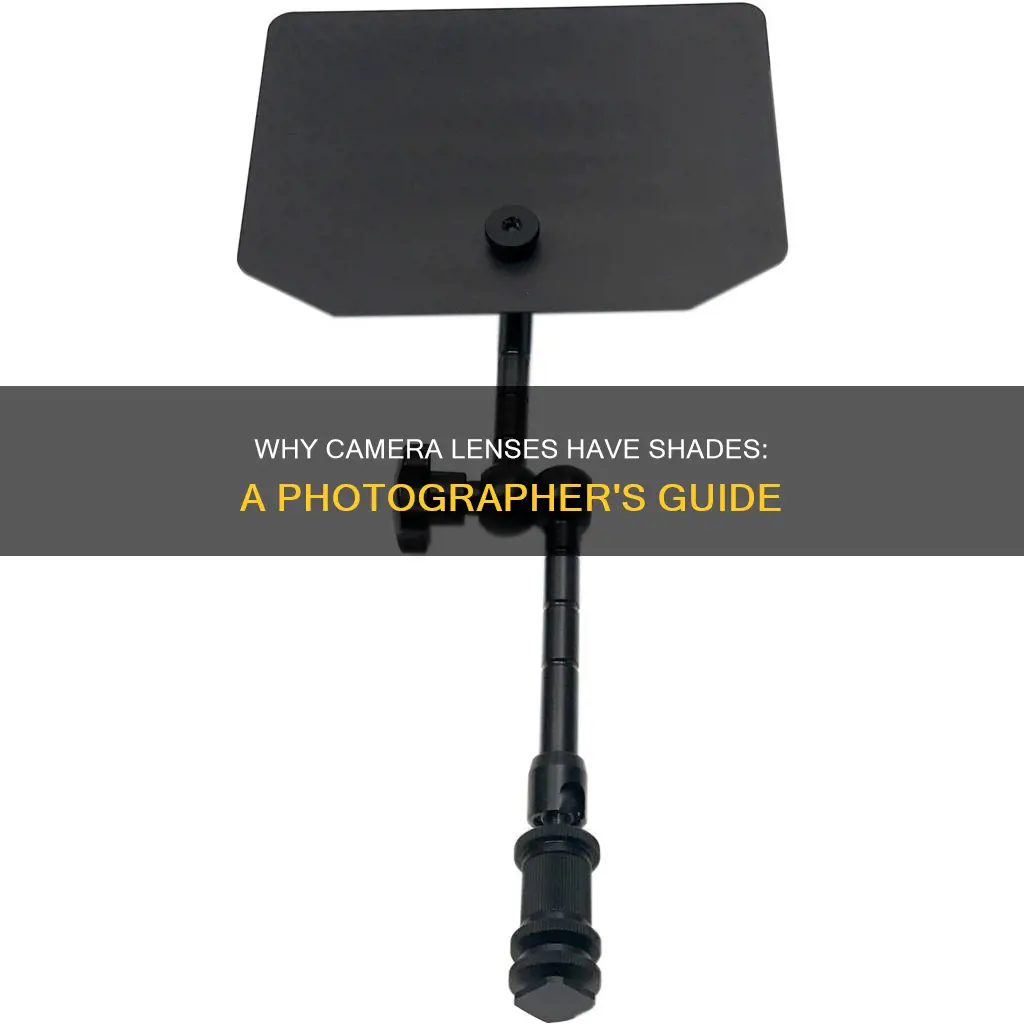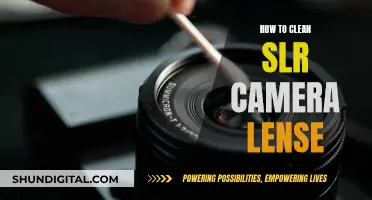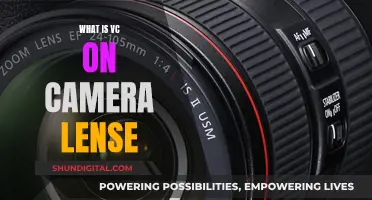
The shade on a camera lens, also known as a lens hood, is an accessory that attaches to the front of a camera lens to block unwanted light from entering the lens and causing lens flare and glare. This improves image quality by increasing contrast and colour saturation. Lens hoods also offer some protection to the lens from scratches, cracks, and the elements. They are particularly useful in bright conditions, such as when shooting in direct sunlight, or in rough locations where the camera may be knocked or dropped.
| Characteristics | Values |
|---|---|
| Purpose | Block unwanted light, add image contrast, protect the lens |
| Use cases | Bright sunny days, shooting at night near street lamps, shooting silhouettes, seascapes, harsh weather conditions, woodland photography |
| Non-use cases | When you want a flare effect, when the lens hood blocks your flash, when using an adapter ring and filters, long exposures, windy weather |
| Types | Petal, cylindrical, conical, square, round |
| Buying advice | Find a compatible lens hood for your lens model |
What You'll Learn

To block the sun or other light sources to prevent glare and lens flare
A lens hood, also known as a lens shade, is a device attached to the front end of a lens to block the sun or other light sources to prevent glare and lens flare. It acts as a visor for the lens, reducing the amount of lens flare and glare in photos.
Lens flare occurs when stray light, often from very bright sources such as the sun, bounces around within the lens, reducing contrast and overall image quality. The lens hood acts as a shield, blocking or reducing this unwanted light and allowing the lens a clear view of the scene. This results in images with better contrast and colour saturation.
The geometry of a lens hood is dependent on the focal length of the lens, the size of the front lens element, and the dimensions of the image sensor or film in the camera. The shape of the hood can vary from cylindrical or conical to more complex petal, tulip, or flower shapes. These designs take into account the final image's shape and aspect ratio, allowing the longer portions to block stray light while the shorter portions let more light into the corners, reducing vignetting.
Lens hoods are particularly useful in bright conditions, such as sunny days or at sunrise and sunset, and when shooting near strong light sources like street lamps or vehicles with headlights on. They are also beneficial when shooting silhouettes or seascapes, offering protection from spray, and in harsh weather conditions, helping to keep the lens dry.
In addition to their optical benefits, lens hoods offer protection to the lens from accidental damage, scratches, fingerprints, and the elements. They act as a shield, providing a layer of defence against accidental impacts, and can be especially useful when shooting in rugged locations or during windy conditions.
Lenses for Full-Frame Cameras: What's the Difference?
You may want to see also

To protect the lens from scratches and the elements
A lens hood, also known as a lens shade, is a device used on the front end of a lens to block the sun or other light sources to prevent glare and lens flare. It is usually made of plastic or metal and can be attached to the front of a camera lens.
Lens hoods offer a degree of physical protection for the front element of your lens. They can help prevent accidental bumps, scratches, fingerprints, or even rain and snow from hitting the lens. They are an added layer of protection for the front lens element. While there is no guarantee that a lens hood will protect your lens from drops and bangs, it is far better than not using one at all.
Lens hoods are particularly useful when shooting outdoors or in any shooting situation where you will be working with strong light sources. They can be used in most situations and won't harm your photography.
- Bright sunny days or at sunrise and sunset when the sun is low in the sky.
- Shooting at night near street lamps, cars with their lights on, or buildings.
- Shooting silhouettes where the subject is backlit.
- Shooting seascapes for protection against sea spray.
- Shooting close to waterfalls for added protection against spray.
- Harsh weather conditions such as rain and snow to keep your front element dry.
- Photographing in fog or misty conditions.
- Woodland photography during or after rainfall.
- Taking photographs handheld for extra protection against accidental knocks.
- Shooting in precarious positions, just in case!
Lens hoods typically come in two styles: cylindrical or petal-shaped. Cylindrical lens hoods are usually fitted to longer focal length lenses, while wide-angle lenses will have a petal-shaped hood.
Megapixels: Camera Lens Quality or Marketing Ploy?
You may want to see also

To improve image contrast
Camera lens hoods, also known as lens shades, are an invaluable accessory to improve image quality and lens durability. They can be particularly useful when shooting outdoors or in bright, sunny conditions, where they can shield the lens from unwanted stray light and reduce lens flare, thereby improving image contrast.
How Lens Hoods Improve Image Contrast
Lens hoods improve image contrast by blocking unwanted light from entering the lens and causing lens flare and glare. This is particularly useful when shooting in bright light conditions, or when there are strong light sources present, such as the sun. By reducing the amount of scattered light that hits the lens from an angle, lens hoods help to prevent a washed-out look in images, where contrast and colour saturation are reduced.
Lens hoods are especially beneficial when shooting towards the sun or other bright lights, as they dramatically reduce the risk of lens flares. They also improve overall contrast and colours in a photo, even when you aren't in direct sunlight. Any stray light sources that strike the front element of a lens could reduce contrast and wash out an image.
When to Use a Lens Hood to Improve Image Contrast
Use a lens hood whenever possible to improve image contrast and reduce flare. They are particularly useful in the following situations:
- When shooting in bright, sunny conditions, or at sunrise and sunset.
- When shooting at night near lamps, buildings, or vehicle headlights.
- When shooting silhouettes or backlit subjects.
- When using off-camera light sources, such as flash or bright lights.
- When shooting in harsh weather conditions, such as rain, snow, or fog, to protect the lens from water droplets and improve image contrast.
- When shooting in woodland or forested areas, to prevent water droplets from falling onto the lens and reducing contrast.
- When shooting hand-held photos for extra protection against accidental knocks and bumps.
Types of Lens Hoods
Lens hoods typically come in two styles: cylindrical and petal or tulip-shaped. Cylindrical lens hoods are usually used with longer focal length lenses, such as telephoto lenses, as they offer more protection without appearing in the frame. Petal-shaped hoods, on the other hand, are designed for wide-angle lenses and lenses that go to wider angles. They have curved notches or cut-outs that block light while maximising the frame size.
Humidity and Camera Gear: Is 43% Too Low?
You may want to see also

To add physical protection to the lens
A lens hood or lens shade is an accessory that attaches to the front of your camera lens. While it may make your camera look more professional, its purpose is not purely aesthetic. It serves as an added layer of protection for the front lens element, shielding it from accidental impacts, scratches, fingerprints, and falling snow and debris when shooting in harsh weather conditions.
Lens hoods are particularly useful when shooting outdoors or in any situation with strong light sources, as they block unwanted light from entering the lens and causing lens flare and glare, which can wash out your images and reduce contrast and overall image quality.
Lens hoods come in two different shapes: cylindrical and petal or tulip. Cylindrical lens hoods are longer and usually accompany prime or telephoto lenses. Petal lens hoods, on the other hand, are shorter and have curved notches designed to block out light while maximising the frame size offered by a wide-angle lens and full-frame camera sensors.
While lens hoods are beneficial in most situations, there are times when you may need to remove them. For example, if you want to create a lens flare effect in your photo, if the lens hood is showing in your photos, or if you're using certain filters or accessories that prevent you from attaching a hood. Additionally, in windy conditions, a lens hood can catch the wind and cause camera shake, resulting in blurry images.
Lens Compatibility: Using Old Olympus Lenses on New Cameras
You may want to see also

To keep the lens clear in bad weather
A lens hood, also known as a lens shade, is an invaluable piece of camera equipment that shields lenses from unwanted stray light, water droplets, and adds extra lens protection against accidental damage.
- Understand your gear and its limitations. Many high-end cameras are weather-sealed, which means they can withstand rain and snow without additional protection, but this does not mean they can be submerged. Ensure that your camera and lens are weather-sealed before heading out in bad weather.
- Use a lens hood to keep the lens clear of rain and snow. The extra ledge will help keep the lens free from rain and snow, giving you enough time to capture an image.
- Keep the lens dry. Use a protective rain cover, or in a pinch, a non-biodegradable plastic bag. Make sure all the rubber doors covering your camera's inputs are sealed, and keep a clean, dry cloth on hand to wipe away any condensation or water on the outside of the camera.
- Protect your gear from extreme temperatures. Most cameras are rated to work between -10 and +40 degrees Celsius (14-104 degrees Fahrenheit). Keep an extra battery in a temperature-controlled place, such as your pocket, to be warmed by your body heat.
- Be mindful of sand and wind. Sand can get stuck inside the lens and cause spotty pictures or damage moving parts. A stiff breeze can easily blow over a tripod, so anchor your gear using sandbags or hang a camera bag from the tripod's centre column to weigh it down.
- Keep your gear safe from impact. A lens hood can also help protect your lens from accidental bumps and scratches.
Understanding Camera and Lens Lifespan by Shot Count
You may want to see also
Frequently asked questions
A lens hood, also known as a lens shade, is a device used on the front end of a lens to block the sun or other light sources to prevent glare and
There are several reasons to use a lens hood. The main reason is to block unwanted light from causing flare in your photographs. It also helps protect the lens from damage and keeps the lens clear in bad weather.
You should use a lens hood when you want contrast in your images, when there are multiple light sources, and when you're shooting in rough and rugged locations.







